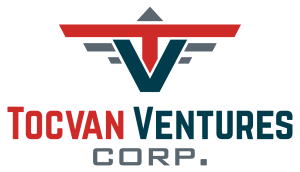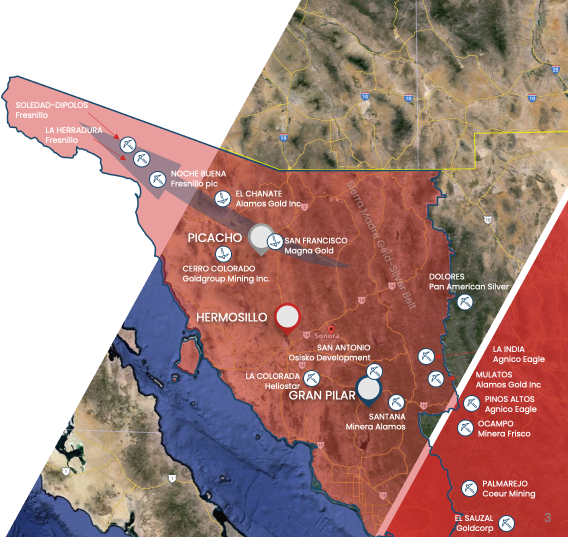
El Picacho Project
Sonoran Desert
Au-Ag
Advanced Stage – Targets Identified
100% interest
2,413.7 Ha
Shear-zone hosted / Intrusion-related Au Systems
Tocvan Ventures
Expansion drilling to follow up recent drill program

The El Picacho Gold-Silver property is interpreted as an orogenic gold system within the regional Caborca Orogenic Gold Belt known for producing gold mines that include La Herradura (>10 Moz Au) and San Francisco (>3 Moz Au). The project is 140 kilometers north of Hermosillo and totals 24 square kilometers. Five primary zones of mineralization have been identified across the property totalling over six kilometers of prospective trends. Surface sampling and historic workings have identified high-grade gold and silver values. The project has only seen widely spaced reconnaissance drilling with no follow-up. Tocvan believes this provides an excellent opportunity for discovery of a muti-million ounce district.
Mining operations across several target areas took place during the 1950’s to 1970’s, profiting from high-grade gold veins. Evidence that mining occurred includes considerable development of mine workings at target areas such as San Ramon, La Cornea, La Tortuga and Murcielago. The quantity of gold exploited is unknown, but is thought to be at least a few thousand ounces due to the large number of underground workings, pits and placer areas throughout the property.
Different areas of the property were explored by different companies at various times in the past. The abundant information gathered has defined clear targets for drilling. In the nineties Geomaque mapped, sampled, trenched, and drilled (>1000 meters RC). In 2000, Phelps Dodge (Freeport) optioned the property and performed regional scale mapping over more than 6,000 Hectares in the area. They collected rock samples for geochemistry and drilled five RC holes. Timmins in 2011-2013 mapped, collected geochemical samples and drilled RC holes. Timmins drill holes were widely spaced over the property. The most recent work was performed by Millrock Resources partnered with Centerra Gold during 2017 and 2018. More detailed mapping (1:2000 scale) was conducted in select areas, soils were sampled over the entire property, and geophysical work included magnetometry and IP geophysics were conducted. Core drilling by Millrock and Centerra was conducted in the northwest property area. None of the target areas generated by the data collected above have been adequately drill tested. (Summarized from internal Millrock Report, 2020)
including 12.2-meters of 2.0 g/t Au and 7 g/t Ag
including 3.1-meters of 7.6 g/t Au and 9 g/t Ag
Hole SRA-22-005 returned 4.6-meters of 0.5 g/t Au and 5 g/t Ag, from 21.4-meters
Hole SRA-22-007 returned 7.6-meters of 0.3 g/t Au and 17 g/t Ag, from 24.4-meters
Including 3.1-meters of 0.6 g/t Au and 31 g/t Ag
El Picacho lies in the Basin and Range province characterized by northwest-trending valleys and ranges. Paleozoic rocks, including quartzite and limestone, locally overlie Precambrian rocks. The valleys are covered and in-filled by recent gravels.
Regional geology is widely varied by lithology and by age. Precambrian rocks include metamorphic gneiss, schist and pegmatite and intrusives gabbro and granite. Jurassic rocks include weakly metamorphosed volcano-sedimentary rocks and sedimentary rocks. Cretaceous rocks are intrusive, volcanic and extrusive rocks. Tertiary conglomerate is also found throughout the region. These lithologies are all found at El Picacho and elsewhere in Northeastern Sonora. All the above lithologies are in places covered by alluvium and colluvium.
Multiple orogenic events and intrusions have deformed and metamorphosed the Precambrian to Tertiary rocks above. Tectonic extension has produced large blocks and valleys covered in colluvium and alluvium at El Picacho as well as throughout the Sonoran Desert.
The El Picacho property lies in a portion of Mojave-Sonora (Caborca) gold belt characterized by the presence of Precambrian to Tertiary age rocks represented by different grades of deformation and metamorphism. The rocks principally involved in the process of deformation and associated with the gold mineralization in the region are of Precambrian, Jurassic and Cretaceous age.
The El Picacho project has numerous gold-silver occurrences with trace to small amounts of other metallic minerals (As-Sb-Te). The gold most commonly occurs in granitic gneiss that contains principally free gold and occasionally electrum. The associated mineralogy, the possibility of associated tourmaline, the style of mineralization, and fluid inclusion studies at the nearby San Francisco deposits suggest the Picacho prospect may be of mesothermal origin.
Mineralization is associated with quartz veins and veinlets and quartz stockwork containing sulfide box works, wulfenite, galena, copper oxides, migmatite and occasional visible gold. The highest-grade samples contain sericite, siderite and calcite alteration. Mineralization is structurally controlled at El Picacho. Evidence for this interpretation includes the emplacement of veins in the faults mapped at several target areas and in historic mine workings. As is seen in the field, high angle and low angle structures appear to channel the mineralizing fluids, especially the higher-grade quartz / gold veins. This structural setting is similar to those of the Herradura and San Francisco mines. (Summarized from internal Millrock report, 2020)
Diverse Terrain:
Rich Mineral Resources:
Copper Production:
Gold and Silver Mining:
Mining Infrastructure:
Mining Regulations:
Investment Opportunities:
Für weitere Informationen bitte geben Sie ihre E-mail Adresse hier ein